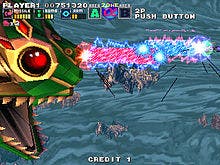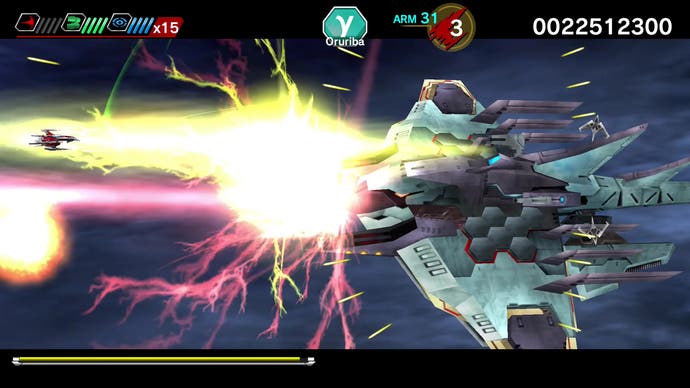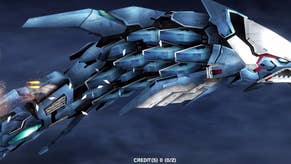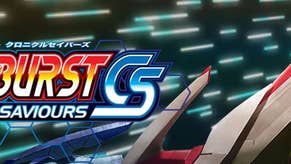How Dariusburst: Chronicle Saviours resurrects an arcade legend
Swimming with the fishes.
Taito's seminal Darius series - like its arcade competitors R-Type and Gradius - is one of the franchises which helped shape and define the 2D horizontal shooter genre during the coin-op dreamland that was the mid-to-late '80s. However, unlike its aforementioned contemporaries - which have sadly fallen dormant due to developer collapse and publisher apathy respectively - Darius has more or less managed to remain in active duty since those glory days.
After a prolonged period of absence, Dariusburst launched on the PlayStation Portable in Japan back in 2009, the first all-new entry in the series since G-Darius over a decade previously. Developed by Patapon studio Pyramid, this refreshing take on Taito's classic capitalised on the Japanese resurgence of Sony's handheld, and launched a spin-off Darius sub-series which has since expanded to arcades and smartphones - and, more recently, to PC, PlayStation 4 and PS Vita in the shape of Dariusburst: Chronicle Saviours, which launches worldwide this month. It's been a remarkable endeavour for all concerned.
"The PSP version of Dariusburst was instigated by Hiroshi Aoki after years of pushing the plan through with Taito until it was at last accepted and developed," explains Pyramid senior vice president Junichi Kashiwagi. While the original version of Dariusburst was a consumer release first and foremost, Pyramid was keen to maintain that vital link to the franchise's former stomping ground: the arcade.
2010's Dariusburst: Another Chronicle was a multi-screen coin-op behemoth, housing two 32-inch monitors to mimic the three-screen setup seen in the original 1986 Darius cabinet. Another Chronicle was a rare instance of a domestic game getting an arcade port rather than the other way around, and swiftly became the stuff of legend among coin-op lovers; a near-mythical beast rarely encountered in the wild. An augmented Android and iOS port would follow in 2012 under the subtitle Second Prologue, which included extras taken from the arcade version.
Which brings us to Chronicle Saviours, the first major home release in the series for what seems like an eternity, and the culmination of six years of development, iteration and evolution. Taito - now a wholly-owned subsidiary of Square Enix - has allowed the compact and agile Pyramid to do the heavy lifting in terms of development, and a productive relationship has blossomed between the two companies.
"We've worked closely with Taito since the inception of the series on PSP," says Pyramid producer and expat James Wragg. "It originally came about due to our passion for the series matching that of the then-producer, Hiroshi Aoki. Of course, shooters weren't selling that well at the time so getting a green light wasn't easy, but it was the chance to revive a much-loved series, so we kept pushing. Aoki-san was also very passionate about the game, so we didn't always see eye to eye, but it lead to a game we were very proud of. For the arcade version, Taito went as far as creating a new cabinet for our game, which was a great honour, of course."
Despite the shifting nature of the games industry, Pyramid has managed to retain the nucleus of the Dariusburst team over the past six years, and this has undoubtedly helped when it comes to maintaining focus and pushing the concept forward.
"The core members have been with Pyramid for seven to eight years and have been involved with every version of Dariusburst so far," says Wragg. "Outside of that, they've worked on platforms from Sharp X68000, SNES and Saturn, arcade, mobile, browser and more. They've developed shooters, RPGs, RTS, rhythm games and more; we're a versatile bunch."
Despite this degree of internal consistency, the core team has nevertheless been open to outside influence, and has welcomed the input of those who have been part of the Darius story since its birth in the 1980s. Wragg reveals that over the years, several past members of the Darius team have been involved with development. "The most obvious is Hisayoshi Ogura, or 'OGR' to the fans, composer for the original Darius game," he says. "He composed a tune for the PSP version - 'Hello 31337' - and many of his original tracks feature in Chronicle Saviours. This time around, we've also had some help from members of the Darius Gaiden and G-Darius team, which gave us access to design documents from those projects."

Dariusburst as a franchise has remained faithful to the original games, factoring in those elements for which the lineage is famous - namely fish-like robotic enemies, branching routes and gigantic bosses, each one preceded by warning text which flashes disconcertingly on the screen. Mechanical designers Takayuki Yanase (Mobile Suit Gundam, Metal Gear Rising) and Kanetake Ebikawa (Full Metal Panic, Blue Submarine No. 6) have been brought in to make these aquatic beasts even more striking and elaborate, and as a result Dariusburst boasts some of the most eye-catching enemies the series has witnessed so far - which is certainly saying something. However, the biggest innovation is hinted at in the title - the "Burst" cannon which unleashes a volley of laser fire that can turn the tide of some of the stickier situations you find yourself in. The way in which this weapon system has developed over the past six years is a good indication of the intense evolution the Dariusburst series has undertaken.
"With each version of Dariusburst we have added some kind of system change," says Kashiwagi. "Such changes were big in Darius Gaiden or G-Darius. With Dariusburst, the original plan was to have the burst weapon as a saturation attack, burning enemies away. After starting the development in 2009, a number of different proposals were made, but seeing the trend in Taito horizontal shooters like G-Darius and Metal Black for beam weapons, we added the same idea to the core of the Dariusburst system.

"Both your ship and the bosses have a beam attack, and we decided on having each stage climax in a beam battle with the boss. As the two Taito titles mentioned were competitions based on button mashing, we decided to make ours based on timing. The staff came up with a gimmick that could be used both in attack and defence, and ended up with a unique system where the beam weapon can be detached from the main ship. With this idea in mind, we boosted it to the current Standard Burst, Fixed Burst and Counter Burst, usable in both attack and defense. In the PSP version, the Counter Burst was added at the very last moment - this is why it is really only ever useful in boss fights."
For Another Chronicle, the burst system was augmented by alterations to other parts of the game; the tools may have been the same, but the way in which the player could use them changed. "The original game features much of what makes Dariusburst what it is," explains Wragg. "The Burst, Counter Burst and Fixed Burst have been there since day one, but the arcade, with its dual monitor and higher specs allowed us to go further: 4 player simultaneous play, bigger, better bosses, more ships to play with and huge numbers of on-screen enemies.
"This allowed us to have the player fire a Burst beam mid-stage and wipe out hundreds of enemies at a time and the dual screen added to this greatly. A bigger playing field and the ability to switch ship direction - along with Link Burst beams - go a long way in adding more strategy and fun when playing co-op. New ships - such as the Genesis and Gaiden - are nods to past Darius games and each offers a varied style of play. Then there's new play modes; while we stick with the Darius branching levels, we always add something new to the mix."
Chronicle Saviors - being a port of Another Chronicle - naturally contains all of these elements, but goes the extra mile in terms of content. "We felt we needed more," says Wragg. "Which is where Chronicle Saviors Mode comes in: over 200 stages of finely-balanced gameplay, with an all-new ship, six brand new bosses and over 100 music tracks from Zuntata. It also features a story, explaining the Burst series and touching on some of the previous episodes, too."
Zuntata is a name that will be instantly recognisable to any self-respecting Taito fan, of course. The company's legendary in-house music team was founded in 1983 and over the years has been responsible for the soundtracks to some of the firm's most beloved franchises - including Darius. Zuntata has been involved since the original Dariusburst in 2009, and retains a key role in the production, even going as far as to dictate the flow of the gameplay itself. "Sound is a big part of the Darius franchise and Zuntata keep a close eye on our development builds, fine-tuning the effects and providing a soundtrack worthy of the series," Wragg says. "It's probably one of the only games where level play time is decided by music track length."

The advancement of technology can also be keenly felt with Chronicle Saviours - the inexorable march of home hardware means that Pyramid has been able to expand the scope of the game dramatically since the inception of the PSP original in 2009. "The main difference is the number of enemies on screen," Wragg states. "With the PSP, we only managed around 10, but the arcade - and therefore Chronicle Saviours - has around 100 at peak times. Co-op play is also something PS4 and Steam versions have made possible. Then there's dual-monitor display; it's something we can only offer on PC, but it's the closest thing to the arcade you can get." On the Sony versions, the arcade's gigantic screen is replicated by letterboxing the screen - not an ideal solution, but one which works well enough.
It's obvious from speaking to the team at Pyramid that a straight port of the arcade version was never going to be satisfactory, hence the introduction of the aforementioned Chronicle Saviors mode, which takes the concept of branching routes and ramps things up considerably. For Kashiwagi, the extra work was essential to ensure that gamers who aren't necessarily into shooters will be drawn into the title.
"I am personally a fan of shooters, but when I think of gamers in general, it does feel that 2D shooters are commercially more limited when compared to other games," he admits. "A 'normal' gamer would feel that the game is complete when they clear it. A shooter fan is different. They will think 'let's practice for no miss, one credit clear! Let's find a routine to reap the best possible score! Once easy is done, try normal, then hard!' There are many ways to play such a game, but a 'normal' player would not play this way.
"I was inspired by the Family Tennis series from Namco, which added a RPG-like mode and increased the content while having a good reason for the player to improve their skill. I thought I would do something similar for a 2D shooting game. What we wanted to do was to make a 2D shooter - usually thought of as difficult - into something non-shooter fans can enjoy as well, with the same amount of content as a packaged retail game. This is achieved while keeping the density you would expect from a 2D shooting game."
Wragg expands on this, stating that Chronicle Saviours has very much been created with hardcore and casual players in mind. "We have to cater for both as much as possible," he says. "Make a game that's too hard and you lose the less dedicated player, go the other direction and the core players lose interest. This was our largest challenge when designing the arcade game because arcades need to keep their players coming back - hence the infinite lives mode in Arcade and a range of difficulties in the Chronicle levels allowing for casual play as well as the core players. It's a philosophy we've retained for Chronicle Saviours with the CS Mode: anyone can play and enjoy it, but to finish all the levels will take some skill."
Launching on three different platforms was also a challenge for the team; ensuring that the core gameplay remained intact across PS4, Vita and PC was quite a task. "Making sure we can offer as close as possible an experience to the arcade machine on all three platforms without compromising anything in the process was by far the biggest challenge," admits Wragg. "This meant the Vita version required a lot of optimisation to squeeze out every last drop of performance and enable the same volume of enemies and effects on screen as the PS4 and Steam versions. The Steam version presented its own challenges of course; so many hardware variations and configuring it to run on multiple monitors for a true arcade in the home experience." The hard work has paid off, however; while the there are differences to note - the Vita version lacks co-op play, for example - it's astonishing to see how close all three are in terms of visual clarity and performance.
The Dariusburst project has clearly been successful enough in Taito's eyes, and the team at Pyramid deserves a massive amount of credit for keeping this venerable shooter brand alive during a period where the genre has fallen out of fashion with mainstream players. However, Wragg is unsure if the release of Chronicle Saviours will create a suitable springboard for further excursions in the world of Darius. "That's something you'll have to ask Taito," he laughs. "Of course, we would love to work on a new Darius if the chance presents itself."













